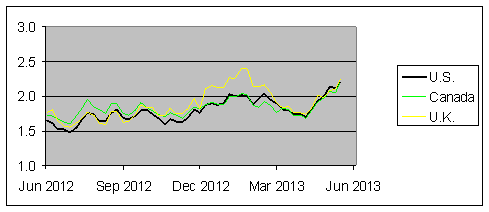The yield on 10-year U.S. Treasuries has jumped 50 basis points since the start of May, leading some to speculate that the market is already starting to price in anticipation of an end to the Fed’s bond-buying program. There may be some truth to that, but it’s only part of the story.
It’s helpful to begin by looking back to when the Fed started the latest rounds of large-scale asset purchases. On November 3, 2010, the Fed announced its intention to purchase $75 B each month in long-term Treasuries through June of 2011, a measure popularly referred to as QE2. The theory was that these purchases would reduce the interest rate on those securities. But what happened over the next two months was the 10-year yield went up 60 basis points.

Interest rate on 10-year Treasury security, weekly, Jan 1, 2010 to June 13, 2013, from FRED. Vertical lines at Nov 3, 2010 and Sep 13, 2012.
That does not mean that the Treasury purchases had no effect. Most observers knew QE2 was coming well before the Fed made its official announcement. It may well be that at least some of the reduction in interest rates in the months prior to the announcement in fact reflected an anticipation of what everybody saw coming, with the effects completely priced into the bond market by the time the official announcement came.
But there’s another complication. One of the reasons that everyone expected QE2 was that we could all see for ourselves that the economy remained weak. Part of what persuaded the Fed to move, and what persuaded everybody else that the Fed was going to move, was a very weak labor market and signs of disinflation. But these same factors would also tend to depress interest rates even if the Fed didn’t buy a single bond. Some of the drop in rates in the fall of 2010 was likely caused by anticipation of QE2, but some was also due to a very weak economy.
And the effects of the QE2 itself operated through a couple of different channels. One is the direct consequences of the purchases through a portfolio-balance effect. Estimates of the size of this effect vary, but I think it was not more than 10–20 basis points. But another important tool for monetary policy is the Fed’s communication of its future intentions for the short-term interest rate– for how long is the interest on reserves going to remain at 25 basis points? The Fed can say that it plans to hold short rates down for some time. But actions speak louder than words. When the Fed is putting its money where its mouth is by buying large quantities of long-term securities, it adds emphasis to the declarations about its future intentions. This signaling of future short-term rates is another channel whereby policies like QE2 may affect interest rates.
One sees the same pattern in the figure above for the announcement on September 13 of the current bond-buying program (often called QE3). Rates dropped prior to the bond purchases, with little discernable change after the announcement itself. Again, markets anticipated the move in advance, partly because of statements from Fed officials, and partly because everyone could see signs of economic weakness in the U.S. and the recession in Europe. Maybe it was anticipation of QE3 that brought rates down, and maybe it was a weak economy that was the cause of both QE3 and lower rates.
So are we seeing the same pattern in reverse over the last six weeks with the 50-basis-point run-up in the 10-year yield? The Fed will need to stop its bond purchases at some point. Tim Duy is expecting the Fed will announce a slowdown in the rate of bond purchases at its September meeting; Bill McBride thinks it won’t be until the end of the year.
When it does announce tapering, the Fed will try to reiterate that the rise in short-term rates will still not come until much later. But just as QE3 added emphasis to the declaration of a commitment to an extended period of low interest rates on the way down, ending QE3 will tend to detract from that message as we start to look at the path back up.
And just as a weak economy was the primary reason the Fed embarked on QE3, a strengthening economy will be the primary reason the Fed ends it. And if the economy is strengthening, interest rates will be headed up, regardless of whether the Fed keeps buying bonds or not. It’s worth emphasizing that the recent rise in interest rates has been a global phenomenon, not just something seen in the United States.

Interest rates on 10-year government bonds, weekly, June 1, 2012 to June 13, 2013 for the US, Canada, and the UK.
If you want to claim that the recent rise in rates is just an anticipation of what the Fed is going to do, the story has to be that the U.S. Federal Reserve is causing the whole world to move.
The alternative view is that it’s a big world out there that will ultimately force the Federal Reserve to move.
- Bulenox: Get 45% to 91% OFF ... Use Discount Code: UNO
- Risk Our Money Not Yours | Get 50% to 90% OFF ... Use Discount Code: MMBVBKSM
Disclaimer: This page contains affiliate links. If you choose to make a purchase after clicking a link, we may receive a commission at no additional cost to you. Thank you for your support!


Leave a Reply